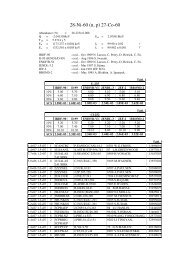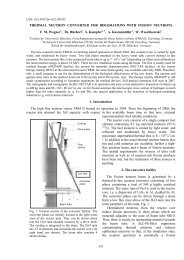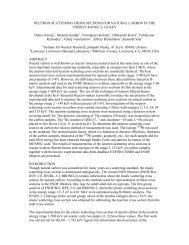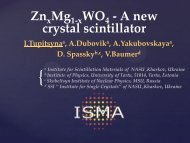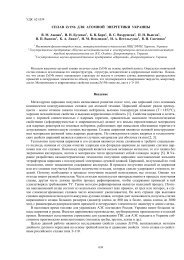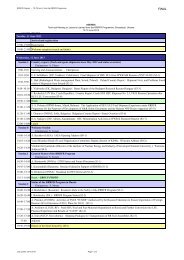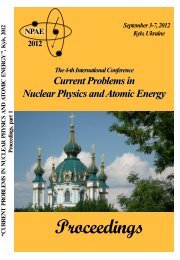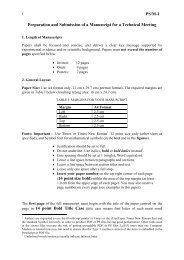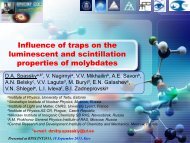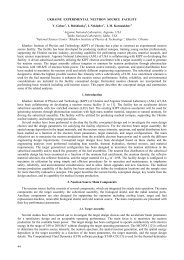International Reactor Dosimetry File 2002 - IAEA Publications
International Reactor Dosimetry File 2002 - IAEA Publications
International Reactor Dosimetry File 2002 - IAEA Publications
Create successful ePaper yourself
Turn your PDF publications into a flip-book with our unique Google optimized e-Paper software.
III.2. Q 0 VALUES<br />
Only the values that are marked as ‘reliable’ in the k 0 database are<br />
included in the intercomparison (see also Table III.2). As specified in Refs [III.2,<br />
III.12], most of the measured data originate from two laboratories: the<br />
WWWR-SM reactor at the Central Research Institute for Physics, Budapest<br />
(labelled KFKI) and the THETIS reactor at the Institute for Nuclear Sciences,<br />
Gent (labelled INW). The Mughabghab recommendation is defined as the<br />
ratio of the resonance integral to the thermal cross-section, and the uncertainty<br />
is the sum of relative uncertainties. Comparison of the ratio for metastable<br />
products is valid if the assumption can be made that the branching ratio is<br />
independent of energy. Evaluated data files that give explicitly the excitation<br />
functions for metastable states support this assumption. The ratio values<br />
derived from evaluated data files are calculated as the ratio of the resonance<br />
integral (see below) and the thermal cross-section in the same file. The<br />
following nuclides exhibit discrepancies:<br />
— 55 Mn: The capture reaction is considered standard in the k 0 NAA, and the<br />
resonance integral and thermal cross-section by Mughabghab were<br />
adopted for the k 0 database. The Q 0 value is reduced by 0.5% if the most<br />
recent Mughabghab recommendation for the thermal capture crosssection<br />
is used. Direct measurements show good consistency [III.2]<br />
(KFKI: 1.035 ± 4.5%, INW: 1.097 ± 3.9%, 1.077 ± 3.3%, 1.041 ± 3.9%),<br />
with a mean value of 1.062 ± 2.8%, where the uncertainty is the standard<br />
deviation. The maximum spread of any measurement from the mean does<br />
not exceed 3.3%. Since there is reasonably good agreement in the<br />
thermal cross-sections and Q 0 values from different sources, the<br />
resonance parameters in evaluated data files are suspect.<br />
— 58 Fe: There is an extremely large discrepancy of more than 30% between<br />
the Q 0 value from the k 0 database and the Mughabghab recommendation.<br />
Resonance integrals in old publications might be susceptible to the<br />
natural abundance of 58 Fe, which was not known accurately for a long<br />
time. Direct measurements of Q 0 by the cadmium ratio method are not<br />
sensitive to the detector efficiency or the abundance. Direct measurements<br />
at several facilities show good consistency [III.2] (KFKI: 0.979 ±<br />
2.1%, INW: 0.981 ± 1.9%, 0.975 ± 1.6%, 0.954 ± 2.9%), therefore they<br />
may be considered reliable. The Q 0 value derived from the JENDL-3.3<br />
file shows less than 5% discrepancy from the value in the k 0 database.<br />
— 59 Co: The value in the k 0 database was adopted from the literature and is<br />
in agreement with the Mughabghab recommendation. Direct measurements<br />
support a somewhat lower value [III.2].<br />
119



